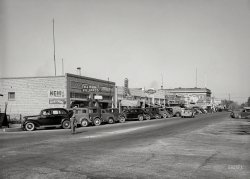
MAY CONTAIN NUTS

Search Shorpy
SHORPY ART

Framed or unframed, desk size to sofa size, printed by us in Arizona and Alabama since 2007. Explore now.
Join and Share
Ad-Free Shorpy
Shorpy is funded by you. Patreon contributors get an ad-free experience.
Learn more.

Recent comments
- Baldwin 62303
- Baldwin VO-1000
- Cold
- No expense spared
- Tough Guys
- Lost in Toyland
- And without gloves
- If I were a blindfolded time traveler
- Smoke Consumer Also Cooks
- Oh that stove!
- Possibly still there?
- What?!?
- $100 Reward
- Freeze Frame
- Texas Flyer wanted
- Just a Year Too Soon
- WWII -- Replacing men with women at the railroad crossing.
- Yes, Icing
- You kids drive me nuts!
- NOT An Easy Job
- I wonder
- Just add window boxes
- Icing Platform?
- Indiana Harbor Belt abides
- Freezing haze
- Corrections (for those who care)
- C&NW at Nelson
- Fallen Flags
- A dangerous job made worse
- Water Stop
Member Photos
The Shorpy
Print Emporium
Print Emporium
Search Shorpy
Search results -- 30 results per page
- Paging Rosie: 1942
- ... been riveted. Love the color!
Compressed Air Rosie is using a pneumatic (air-powered) drill, for those of you who care about ... place the lady in or near the center wingbox.
Poor Rosie Wow! Drilling in these close quarters without eye protection. Not a ... Posted by Dave - 08/21/2012 - 8:34pm -
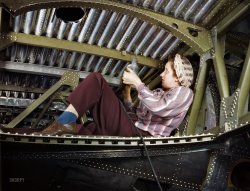
- Rosie Takes a Break: 1942
- October 1942. "Noontime rest for an assembly worker at the Long Beach, Calif., plant of Douglas Aircraft Company. Nacelle parts for a heavy bomber form the background." View full size. 4x5 Kodachrome transparency by Alfred Palmer.
Is that. ... Posted by Dave - 07/27/2012 - 12:26pm -
![Rosie Takes a Break: 1942 October 1942. "Noontime rest for an assembly worker at the Long Beach, Calif., plant of Douglas Aircraft Company. Nacelle parts for a heavy bomber form the background." View full size. 4x5 Kodachrome transparency by Alfred Palmer.
Is that...the same girl as in the picture titled "Madonna of the sandbags"?
[It is indeed. - Dave]
The SocksAnd I love the red socks! The perfect touch for the photo, just like Nat'l Geographic used to do (still does?), a bit of red in every image.
WowAfter all the comments on differing ideas of feminine beauty, this picture is a stunner! You ought to put it in the pretty girls gallery.
The coloursThe vibrancy of the colours in this picture are an advertisement for Kodachrome, even if there's been work done on them. The vibrancy of the blues and the reds, not to mention the colour of her blouse - absolutely stunning. And she ain't bad either - every time you run one of these pictures of women war workers I end up falling in love with women who were born before my 78-year-old mother.
I'll second that"every time you run one of these pictures of women war workers I end up falling in love with women who were born before my 78-year-old mother."
Absolutely. These womenfolk are examples of true, timeless beauty.
Amazing ClarityAlthough everyone rightly raves about the colors from these old Kodachromes, what amazes me is the absolute clarity of the pictures even when viewed full size. This is an aspect of the large format (4x5) combined with, I'm sure, some very expensive glass. I can't even imagine what the megapixel equivalent would be, if you could even get this clarity with a digital camera.
(The Gallery, Kodachromes, Alfred Palmer, Pretty Girls, WW2)](https://www.shorpy.com/files/images/1a35328u1.thumbnail.jpg)
- Avenging Angels: 1943
- ... for the Office of War Information. View full size.
Rosie the Riveter Looks like a Rosie the Riveter working on the platform on the right on the plane in the ... Posted by Dave - 12/07/2021 - 1:11pm -
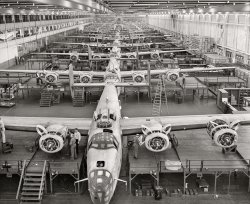
- Rosie the Router: 1942
- December 1942. "Mary Miller, operator of a router at the Boeing plant in Seattle, drills holes in a part for a new B-17F (Flying Fortress) bomber. The Flying Fortress, a four-engine heavy bomber capable of flying at high altitudes, has performed w ... Posted by Dave - 11/07/2013 - 7:12pm -
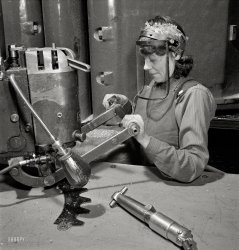
- The Ladies Who Lunch: 1943
- ... for a long day in the roundhouse.
This is real "Rosie the This is real "Rosie the Riveter" stuff! Marcella - what a gal!
LUNCH PAILS Note that ... Posted by Dave - 06/08/2017 - 8:42pm -
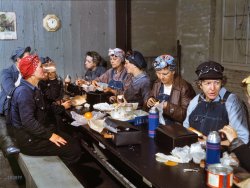
- Approach With Caution: 1919
- ... most dangerous street machine I have ever seen.
Before Rosie the Riveter I love showing people these sorts of images, in light of ... 1919, look like they just ... have jobs. I love the proto-Rosie coveralls and headscarves, the likes which show up again a scant fifteen ... Posted by Dave - 09/29/2014 - 9:43am -
![Approach With Caution: 1919 San Francisco City Hall circa 1919. "Peerless truck." Three young ladies aboard what seems to be some sort of street-cleaning, finger-ripping machine. Hide your children and stand clear! 5x7 glass negative by Christopher Helin. View full size.
FrighteningThe single most dangerous street machine I have ever seen.
Before Rosie the RiveterI love showing people these sorts of images, in light of the fact that most of our images of American Women in Action come from the WWII era, where they were pressed into service because men had gone to war. These ladies, in 1919, look like they just ... have jobs. I love the proto-Rosie coveralls and headscarves, the likes which show up again a scant fifteen years later as something unusual in "The Saturday Evening Post" and LIFE magazines.
Crazy Contraptions I think if Rube Goldberg had ever designed a truck, it would look just like that.
Finger ripping is putting it mildy.That truck looks as if it was designed to inflict injury. I hope those women got hazardous duty pay.
AwesomeI just stumbled upon this site. I love vintage photos, and this one is terrific -- who knew that there were women filling roles like this in the early 20th Century?
Safety guards ! Safety guards!We don't need no steenking safety guards!
GoldbergianIn 1904, freshly minted from the UC-Berkeley Engineering School, Rube Goldberg took a job with the San Francisco Department of Water and Sewers. Although he left in a few months to be a cartoonist for the SF Chronicle, it appears he kept his hand in by designing machines for the Department.
More Danger LurkingAnd if you do get passed the hair pulling - finger ripping apparatus, there's always that two foot section of lead pipe on the floor to worry about.
Tot-TwirlerWhen I see gear like this, I'm just going to start labeling it "babyshredder."
The third operator was necessary for when the first two inevitably got caught in the machinery.
Count your fingersI trust those open belt and chain drives are OSHA approved. But I bet it was more interesting when you could see the parts of machinery doing their thing.
Pilot for short subject seriesI believe this is a still from "The Three Stoogettes", an unsold movie short series which was way ahead of its time -- "We'll clean your sheets, we'll clean your streets, in half the time, no more grime ... zots!"
PeerlessI infer that to mean returning from the job with fewer of one's peers in the passenger seat than one left with that morning.
Hey HoneyThis truck looks a heck of a lot like a "honey dipper" to me. Other than the 1919 running gear and mechanism, they still look like that today.
[Like our previous street flusher, this rig was one of many deployed as a public-health measure during the flu epidemic of 1918-1920 to control dust. - Dave]
WowserDefinitely high tech for its day. The belt drives appear to be increasing the speed to a (pump?) under the end of the tank. I can't see any spray nozzles so I would assume it's used to refill the tank?
Street Cleaner??It looks more like the kind of equipment that would be used to spread liquid asphalt (aka tar) on a roadway before spreading a layer of stone on it. Admittedly, it's very clean, so this might have been a publicity shot for the manunfacturers. "So simple the ladies can operate it!"
You can't make this upThanks to Jim Page for informing us "Here we see a 1918 Peerless Isadora-model Pinchmaster 3000 truck". "Pinchmaster", could there be a more appropriate name of it than that?
[Jim did make that up. The reference to Isadora Duncan was especially sly. - Dave]
Original power washerBelt driven PTO runs the rear mounted pump. Two control levers by the closest operator regulate how much flow is produced to swish the road apples to the gutter.
Vehicle IDI usually allow others to handle the vehicle ID chores here at Shorpy, but since no one has stepped up: Here we see a 1918 Peerless Isadora-model Pinchmaster 3000 truck. Few were made, as this model required a three-person crew, and the replacement 1919 Peerless Fargo-model Chopmaster 4000 only required a crew of two-and-a-half (two in a pinch).
The three P'sPeerless, Packard and Pierce Arrow were makers of some of the best cars and trucks of their era. Chain drive has its advantages: (1) less unsprung weight; (2) ease of gear ratio change; (3) lack of rear wheel spin in soft ground; (4) great sound going down the road.
CrewThe third crew member is the flight engineer.
Unsightly Limbs and Appendages...Removed While You Wait! Just step a little closer, please.
(The Gallery, Cars, Trucks, Buses, Chris Helin, San Francisco)](https://www.shorpy.com/files/images/SHORPY-GN-006A.thumbnail.jpg)
- Wright Cyclone: 1942
- ... transparency by Alfred Palmer. View full size.
Rosie the riveter? Nope. This is her sister.
RH - LH The motors are ... Posted by Dave - 05/10/2017 - 12:19pm -
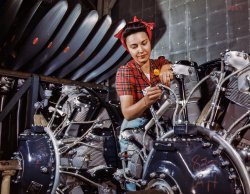
- Avenging Angel: 1942
- ... aged woman in a 1940 UK setting ~73 years later.
Rosie the Riveter? As part of our world war II time line - we could include ... Posted by Dave - 02/15/2019 - 9:13pm -
![Avenging Angel: 1942 "Now I am become Death, the destroyer of worlds."
October 1942. "Woman at work on bomber motor, Douglas Aircraft Co., Long Beach, California." Kodachrome by Alfred Palmer, Office of War Information. View full size.
Recently spotted on PBSNo, but she's the spitting image of Ruth Gemmell who played a similarly aged woman in a 1940 UK setting ~73 years later.
Rosie the Riveter?As part of our world war II time line - we could include the working women who built the machines to doom Hitler.
[This one is more Ruby the Ratcheter - Dave]
Engine installerFor one thing, I think this picture is posed as well as the other one with the 3 ladys also installing engines, you wouldn't be that clen and neat or wearing a loose hanging sweater and rings on your fingers doing any type of engine or mechanical work. Safety would require anyone to remove those items to prevent getting stuck on the equipment or any FOD (Foreign Object Damage) to engines while being assembled.
[As we have pointed out elsewhere, most of the Palmer photos were posed. Some were used as studies by illustrators painting recruitment and bond drive posters. - Dave]
It's the Wright engineAfter it's first startup a piston engine will never again shine so pretty. Looks like a Wright Cyclone R-2600, 1,600 hp beast mounted on Douglas' A-20 Havoc.
(The Gallery, Kodachromes, Alfred Palmer, Aviation, WW2)](https://www.shorpy.com/files/images/SHORPY-1a35340u2.thumbnail.jpg)
- Dragon Slayers: 1897
- ... the subject of a Renoir. I can imagine the colors.
Rosie and Mr. Allnutt Does anyone else see the guy with the rifle and the ... Posted by Dave - 05/11/2020 - 4:48pm -
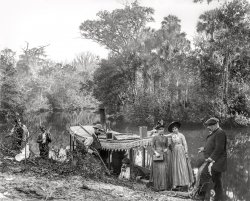
- Take Me to Your Welder: 1942
- ... Palmer, Office of War Information. View full size.
Rosie, is that YOU? This is probably a woman welding. With most of "our ... Posted by Dave - 11/27/2012 - 10:36am -
![Take Me to Your Welder: 1942 June 1942. "Combustion Engineering Co., Chattanooga, Tennessee. Welder making boilers for a ship." A definite 1950s sci-fi vibe here. 4x5 Kodachrome transparency by Alfred Palmer, Office of War Information. View full size.
Rosie, is that YOU?This is probably a woman welding. With most of "our boys" overseas, the ladies picked up the slack and did and admirable job of it!
[The workers in this series of Combustion Engineering photos by Alfred Palmer are all big burly men. - Dave]
(The Gallery, Kodachromes, Alfred Palmer, WW2)](https://www.shorpy.com/files/images/SHORPY_1a35231u.thumbnail.jpg)
- Some Assembly Required: 1942
- ... Looks like Dennis the Menace all growed up.
Rosie the Riveter's younger brother Dennis the Driller!
(The ... Posted by Dave - 05/08/2014 - 12:32pm -
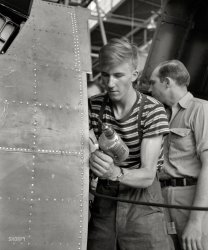
- Mighnon Gunn: 1942
- ... always a housewife. A very noble occupation indeed.
Rosie the Riveter There may have been some women who resented loss of ... Posted by Dave - 09/06/2011 - 1:55pm -
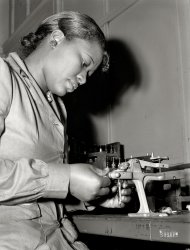
- Cheers: 1937
- ... arm.
Alternate casting suggestions Left to right: Rosie O'Donnell, Robert Ryan, Margaret Hamilton, Walter Huston. Whatever is ... Posted by Dave - 07/19/2012 - 10:17pm -
![Cheers: 1937 September 1937. Craigville, Minnesota. "Saturday night in a saloon." Medium format negative by Russell Lee, Farm Security Administration. View full size.
White gasKerosene lanterns had just an open flame. These pictured were fueled by white gas and the tank had to be pressurized with a hand pump.
Hands-Off policyInteresting that the "Cheers" folks removed the fellow's hand from the lady's shoulder.
Indoor campingPretty rustic. The lights are kerosene lanterns.
Slim pickin'sA James M. Cain novel is written all over that woman's face.
P.A.Do you have Prince Albert in a sign?
Cheers...... it ain't....
Cheers!Hey! Doesn't the guy holding glass appear in the old lead-in for "Cheers"?
Cheers to you too!Oh my gawd it's the folks from the "Cheers!" intro. I must have seen their colorized faces a thousand times (thanks to reruns), and now I know where they're from.
It's like running into long-lost family members. Thanks Dave!
Where everybody knows your nameThis photo was used in the opening sequence of "Cheers." As I remember, it was cropped, to highlight the couple in the center.
0:43Character actorsCentral Casting, eat your heart out!
Cheers!Remember the opening titles to the TV show "Cheers"? It shows old photos of people at bars. One of the "Cheers" photos is THIS photo; they did a close-up of the guy on the left. And yes, I watch too much TV.
Casting? Sure ...That's Howard Hughes, Patricia Neal, and G.W. Bailey on the right. Can't quite make out the lady on the far left, though.
A certain dignity.Even though these people have seen more than their fair share of hard times, there is a kind of dignity in the way the hold their drinks. Serious drinkers for sure. The guy on the right looks kind of like George Clooney. They all exhibit character with a capital C. The guy on the left is giving a major superiority pose to the guy taking a nip.
The lantern in the back corneris a Coleman. I have one just like it. Still works very well.
A rose is a rose is a rose.A barfly is a barfly is a barfly. Nice hat on the alcoholic on the extreme right, looks like he stole it from a horse. Not politically correct but my opinion.
GaslightNotice the fixture in the upper left of the photo is providing light via gas, not electricity.
[As noted below, that's a kerosene lantern. The tank holds the fuel. - Dave]
CamelsAnd I'm thinking that's a Camel cigarette pack on the bar. Recognize the "pillars" from my father's smokes.
That's where I've seem him!Thanks everyone for restoring my sanity. I saw the guy on the left and immediately thought "were have I seen him before?"
I am a child of the 80's so that's why his face was burned into my brain.
Camels for sureI used to smoke them before Pall Mall. Cigarettes didn't have filters in those days. Maybe it was the "Hits or Cracks" game that made me switch from Camels to Pall Mall. As I remember, you guessed if it was the letter H or C under the stamp. If you picked wrong you got slugged on the upper arm.
Alternate casting suggestionsLeft to right: Rosie O'Donnell, Robert Ryan, Margaret Hamilton, Walter Huston. Whatever is transpiring, it's interesting enough for the Missus to delay her request to "light me."
SimplicityThe beer looks great.
Camel Caravan"Camel" was the first nationally advertised and distributed brand of American cigarettes, beginning in about 1914. My dad's first real job was with their NY Distributor, Metropolitan Tobacco, back in 1921. He smoked Camels and only Camels for the nexr 65 years, and never had so much as a cough ("Not a Cough in a Carload"). Back in my time, if I ran out of my favorite, Lucky Strike, I'm bum a Camel from him. Without any exception, they were the strongest, looseest and hottest burning American cigarette that ever existed. They would have killed me after a year! And yes, I do also remember the H and C thing from under the revenue stamp on the packages.
LanternsActually both lanterns are probably Colemans. The one over the bar is an indoor table lamp, which would have originally come with a shade, much like an electric table lamp. The other one is an outdoor type lantern. Both are missing their globes, a rather alarming fact, as the furring strips on the ceiling suggest that it is made of combustible fiberboard, a cheap and popular building material at that time.
Like most Colemans, these burned "white gas," which I believe is actually naphtha, but kerosene models were also available. More common kerosene lanterns have wicks, but pressurized ones do exist. They can be distinguished from the white gas version by the primer cup below the mantle. You fill this cup with alcohol to preheat the kerosene; otherwise, it does not vaporize properly.
BTW, "not a cough in a carload" was the slogan of Lucky Strike, not Camel. And I don't believe for a second that anyone smoked any brand for 65 years without coughing.
Lumberjack TownSome history on this town, and this saloon can be found here:
http://www.lakesnwoods.com/Craig.htm
This place was evidently both a saloon and a barbershop. There are some photos here of other customers, as well as another shot of these folks.
Another image in original Cheers Theme SequenceThe original Cheers Theme Sequence has a picture of my Great-Grandfather W.T. Price II in the Horseshoe Saloon in Junction City, Kansas taken in 1905 by a photographer named Pennell!
(The Gallery, Eateries & Bars, Russell Lee)](https://www.shorpy.com/files/images/8b19903u.thumbnail.jpg)
- A Chorus Line: 1925
- ... They're Sure Not Rosies While all those beautiful Rosie the Riveters captured our hearts... these ladies could be auditioning for ... Posted by Dave - 08/13/2012 - 3:59pm -
![A Chorus Line: 1925 November 24, 1925. Washington, D.C. "Uncle Sam's Follies." View full size. National Photo Company Collection glass negative, Library of Congress.
Love & DeathReminds me of the line from Woody Allen's "Love and Death" where the Napoleon character asks Diane Keaton if she finds him attractive as a man and she says, "I think it's your best bet."
A Chorus LineWhile these are not the prettiest chorus line ever( though I rather like the one in the middle and would love to have her outfit), I think you'd find that a lot of the "ugliness" is the weird strained facial expressions from the awkward pose, and at least one of them looks like she's been sweating a great deal. I'd say these ladies have been putting a lot of practice into a difficult and/or very energetic dance routine and the photographer caught them at a bad moment. I'm also surprised by the apparently wide variety of ages -- second from the right looks no more than 16, while a couple of the others appear middle-aged (though that might be partly due to sweat-streaked makeup).
La Cage aux FollyEven Divine would hang her head in shame.
Some amazingly cute shoes --Some amazingly cute shoes -- but what's that on their faces? Are they the clowns from the previous act?
[Stubble. - Dave]
Uncle Sam's FolliesSo which one is Uncle Sam?
They're Sure Not RosiesWhile all those beautiful Rosie the Riveters captured our hearts... these ladies could be auditioning for a horror movie.
2 out of 7This is a scary lineup of mostly very unattractive women, only two of whom would pass muster today. Are women really prettier today or are we pickier? BTW, I am female so this is not just a male sexist remark.
[What's your opinion of them as men? - Dave]
MistakeI don't think they were supposed to be photographed above the knees.
MisfiledI don't think you can file that one under Pretty Girls. I'm not even convinced all of them are girls.
[I think that's kind of obvious. Isn't it? - Dave]
StepfordTheir shoes have more variety than their (lovely?) faces do! So, variety is the spice of life but a few of these ladies look like twins!
2 out of 7 revisitedI meant 2 were pretty. Now I wonder if 2 (perhaps 3) are even women. Come on, let us in on on the fun.
[The best guess of the Shorpy Gender Certification Committee is that at least two of these girls are women. - Dave]
Miss JaneThe two on each end could be Jane Hathaway's paternal and maternal grandmas.
3 out of 7I'd say that 2nd, 3rd and 4th from right are girls.
They are women.They're not men. Look at the (lack of) muscle on their legs & arms. They're women, just not particularly attractive ones.
[Well I guess you won't be my wingman anytime soon! That's the acrobat-comedian Dick Nash on the left. The other guys were performers in his "Pony Ballet." Below, the leg of the third girl from the left in the photo above without the stockings. - Dave]
(The Gallery, D.C., Natl Photo, Pretty Girls)](https://www.shorpy.com/files/images/15330u.thumbnail.jpg)
- Penn Varsity: 1914
- ... budget cut.
Hmm again They have all been looking at Rosie O'Donnell.
More Support Actually, the jockstrap dates back to ... Posted by Dave - 04/14/2022 - 1:18pm -
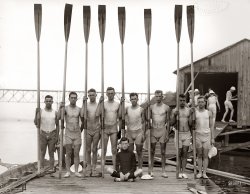
- El Paso: 1903
- ... love with a Mexican girl...
Night time would find me at Rosie's Cantina...etc...
Sign punctuation Something I've always been ... Posted by Dave - 08/20/2012 - 9:55am -
![El Paso: 1903 "El Paso, Texas. 1903." Detroit Publishing Co. glass negative. View full size.
DateDoes the overhead banner not say 1889?
[1903. - Dave]
Telephone cablesWhat a remarkable chapter in the history of telephone communications this photo displays.
Notice how the lower six crossarms on the closest telephone pole, which used to hold 36 wire pairs, have been rendered obsolete by the three cables strung in the upper foreground of the photo.
I'd guess that those cables hold 25 pairs apiece, but they could be a hundred pairs each. Nowadays there can be up to two thousand pairs in a cable.
This marked a glorious transition for a forest of wires to a telephone system with some hope for future expansion.
El PasoNot an automobile to be seen. However we can see streetcar tracks and a Bell Telephone sign.
What else was going on in 1903.When I see the date on a picture or when a Hymn was written I try to relate the date as to what else was going on in the world. El Paso in 1903 with no cars was to change because in Detroit Henry Ford was starting the Ford Motor Co. Driving through El Paso today on I-10 you do not see much of El Paso because of all the cars you have to keep your eyes on.
Great PictureLots to see here. But I keep coming back to the 2nd store from the right. Just beyond the W.G.Walz banner. Does anyone else see two eyes looking at the lens?
El Paso Grand Midwinter CarnivalThe El Paso Midwinter Carnival will take place from January 12 to 17 Inclusive, some of the features of which will be: World's championship Miners' Drilling Contest, prizes $2000; Roping and Tying Tournament, prizes $2000: Fraternal and Civic Parade, prizes $1000: free shows on the streets. Oriental midway, music, parades, bull fights, confetti battles and generally a hot old time.
Ammunition can be bought on the grounds. Programmes of the El Paso Grand Midwinter Carnival shoot will be mailed on application. -- Sporting Life
Oregon and MillsBased on the address of the old Grand Central Hotel and the bend in the streetcar line, this appears to be taken from the corner of Oregon and Mills (formerly St. Louis), looking almost due west. Just to the right of the photographer would be San Jacinto Plaza. 1886 map.
[The label in the lower left corner of the photo says it's El Paso Street. - Dave]
View Larger Map
Mama was a cowgirlMy mother was born in El Paso in 1918 and I imagine it looked pretty much the same 15 years after this photo was taken.
Out in the West Texas...Town of El Paso, I fell in love with a Mexican girl...
Night time would find me at Rosie's Cantina...etc...
Sign punctuationSomething I've always been curious about - this is the first example I've seen on Shorpy since I signed up.
From the pre-Civil War era up through about the turn of the 19th-20th century, sentence fragments on billboards are always followed by periods.
See "Antiquities." in this photo for an example. A nineteenth century hardware store might advertise:
Tools.
Wire Fencing.
Lumber.
Nails and Staples.
You see it in newspaper ads of the 1800's as well.
By the 1920's this usage is just about extinct, you never see it today unless intended to create a mock-dramatic effect.
Somehow there must have been a change in the teaching of business English that caused every ad agency in America to decide "this usage must go!"
[Check out this post, and the comments. - Dave]
Sign Punctuation and the Future of ShorpyYears from now, Shorpy.com (or its successors) may generate comments on the ersatz punctuation evident in commercial signage circa 2009. An infamous example is the use of apostrophies to indicate plurals (e.g. "soda's").
Period Signage, Signage PeriodsThe use of periods in 19th-century signage seems to derive from the similar usage on book title pages. The typographic fashion for long phrases and numerous ornamental typefaces on the same page or sign was perhaps thought to be more confusing to the reader without the periods. So in the present photo, the periods help us to sort out the discrete phrases in the "wordy" sign at the far left: "Wholesale & Retail Dealers in All Kinds of Mexican & Indian Curiosities. Mexican Straw, Felt & Fur Hats." As page and signage design simplified in the 20th Century, the perceived need for the periods became redundant and was dropped from designers' and editors' style sheets. The use of a period in single-word signs such as "Office." or "Coalyard." also renders the word into a declarative sentence, as if spoken in an announcement to the viewer. My favorite badly painted 20th-century building sign, with too-evenly spaced block letters, would have benefited from the addition of periods, or at least better spacing. As seen from the road in Beirut in 1973, it read as one word: "GARGANTUADANCINGCREPERIERESTAURANT"
Electric streetcarsLooking at the streetcar system I don't see any overhead catenary system, but I am viewing the image on a google phone so the detail might not be as clear. In most cities where I have researched, primarily in the southeast, the electric distribution was handled by the streetcar companies as a secondary service to sell excess power not used in the primary transportation network. Streetcars were animal powered until electric motors were improved to handle the cars; steam powered trolleys were considered undesirable and banned in the franchise agreements needed to operate. In some cities the power was generated by the local mill since they had the hydro power, others it was a municipal system or local business group. Lighting was primarily gas until the late 1890's. The electric system is present with a transformer and service cut-ins but I was curious to know if the streetcar was still animal powered?
[The photo shows an overhead catenary line. - Dave]
S. El Paso StreetThis same photo (and 112 others from Detroit Publishing, some already seen here on Shorpy) is contained in the Dover Publications collection "Main Street, U.S.A. In Early Photographs" (1998).
The book's caption notes this is South El Paso Street's 100 block, looking to the south. At the time the photo was taken, this area was the business center of El Paso, "although that hegemony slipped away in the subsequent decade." The two buildings at the extreme right were torn down in the 1980's for the exppansion of the Paso del Norte Hotel.
Believe me, Dave has managed to bring up a great amount of detail from the mud of the original photograph (and I ain't talking about the street.)
Steve Miller
Someplace near the crossroads of America
J.W. HardinThe outlaw J.W. Hardin was killed here 8 yrs prior to the photo. I'd say it was a rather hectic town at the time.
http://en.wikipedia.org/wiki/John_Wesley_Hardin
CoincidenceHaving just watched the HBO series Deadwood last night, I smiled when I saw "The Gem" and "Billiards" on the same building down the street. Must have been a common name in those days.
CURIOUSMIGHT THAT BE A SIGN FOR AN OPTOMETRIST?
[I BET IT WAS. ARE YOU HARD OF SEEING? - DAVE]
Making it workThe sign painters have also effectively worked the decorative brickwork and windows into their design. It is hard to say if the people who originally designed and built the structure on the left had any aesthetic compunction about using the walls as a billboard - or was this the work of later owners? Imagine spending $50 million to build an office building today and then using it for advertising space.
[It is hard to envision. - Dave]
1886 MapThanks Vic for the map. I see those railroads via El Paso. My great-great grandpa went to El Paso from Ohio in 1870's to work on the railroad for few years. I make the connection with family history, personal letters with this map. Thanks so much.
(The Gallery, DPC, Horses)](https://www.shorpy.com/files/images/4a10704u_0.thumbnail.jpg)
- We Met at Work: 1942
- ... place.
Beautiful picture, BTW. My great aunt was a "Rosie" and I have a whole photo album of her and her 'girlfriends' whooping it ... Posted by Dave - 03/19/2016 - 10:02am -
![We Met at Work: 1942 October 1942. "Riveting team working on the cockpit shell of a C-47 transport at Douglas Aircraft Company, Long Beach, Calif. The versatile C-47 performs many important tasks for the Army. It ferries men and cargo across the oceans and mountains, tows gliders and brings paratroopers and their equipment to scenes of action." View full size. 4x5 Kodachrome transparency by Alfred Palmer for the Office of War Information. Happy Valentine's Day from Shorpy!
The planeThe plane in question is the cockpit windscreen of a C-47 transport, the plane that dropped paratroopers into Normandy in advance of D-Day.
[Indeed it is. A second photo of the riveter (see above) correctly identifies the plane. I fixed the caption, thanks. - Dave]
This picture is fake.Erm ... you might want to point out that this photo is
a) not vintage
b) staged
c) very much modern
d) not any of the things you say it is.
For example, the film is wrong. She's wearing purple socks. That dude would be IN THE WAR. Her rivet gun isn't attached to anything, and is the wrong make and model, not to mention about twenty years beyond the correct kind. That's not the cockpit of a B-25. her shoes are wrong. his pants are wrong. that's not how airplanes are made.
Come on. Seriously. It's a decent picture, but to claim that this is 'vintage' is utter bullshit.
------------------------------------------------------------
[A not unusual comment from people who are
a) new to the site
b) ignorant of the history of photography
c) possibly ignorant in general.
(There is a (d) but this is after all a family newspaper.)
Alfred Palmer's large-format Kodachromes for the Office of War Information weren't "staged," they were posed, as studies for recruitment posters, exhibits, etc. It is one of many hundreds in the Library of Congress FSA/OWI archive. As for the riveter on the right, there were of course thousands of young men engaged in factory work during WW2 who were deferred from military draft because they were doing essential war work. And the woman's rivet gun is indeed attached (see below). As for the the plane not being a B-25, the commenter was right about that. It's a C-47. - Dave]
InterestingI've always been amused to see that the ladies in most of these pictures have quite obviously reapplied their lipstick for the camera. This one did not - and it sort of makes me wonder and giggle a little. Did she not want to be seen doing so in front of her male colleague?
Wannabe photo expertThat's Kodachrome for you. A youngster that thinks he knows everything simply cannot accept film reproduction this accurate, that long ago. Clearly this person has just stumbled upon a site he knows nothing about.
Also, his accusations are ludicrous given what David Hall does for a living "off-line," where personal credibility must exist before anything said or written can be believed.
Very funny post, that.
Foy Blackmon
Interesting ReasoningAs a mere dabbler in the study of history, I was previously unaware that:
- Purple socks had either not yet been invented, or were banned from civilian use for some obscure wartime purpose
- The war resulted in the complete absence of all males from the industrial workforce.
Thank you, anonymous scholar, for your insights!
Those kids think they are smarter than us...>>That dude would be IN THE WAR.
That dude might had flat feet or tunnel vision. There were several men classified unfit for the duty, they didn't go home and cry about it. They went to contribute the war effort by working in the factories.
Amusing AssumptionHa! That assumption made a few posts ago is actually pretty funny. It reminded me of a Calvin & Hobbes comic from several year ago in which Calvin is looking at some old family photographs. He asks his father why the old photos are all black and white and only the newer pictures are in color. His put-upon father, acting as my own father did on occasion, explained to him that back then, color hadn't been invented yet. Not just color film, but actual color. Sky, grass, hair, skin and clothing only existed in various shades of gray so that's how it showed up in old photos, movies and TV shows. I'm sure Calvin's mom eventually straightened them both out.
As incredible as digital photography is, it's not really as big an improvement as it's been made out to be. Mainly it's just faster, and that's all that seems to matter much anymore. Working with film had a learning curve, you had to study what you were doing and over time you developed a skill that you didn't previously possess. Well geez...who's got time to screw with that anymore. You can just take a shotgun approach to photography now and if things still don't look right you can pump it up with editing software.
So when a beautifully lit, sharply focused, highly detailed, well composed, color saturated photo is seen now some people are going to assume that it had to have been taken recently and digitally manipulated. Because it looks so much better than the pictures they're taking with their cell phones.
Look at a zoomed in crop of the woman's ear in this picture. You can tell that the back lighting is actually passing through her ear. Her ear isn't just reflecting light, it's glowing. Many modern cameras are capable of recording this kind of subtlety and detail as well, but this photo says so much more about the photographer than the type of camera or film he used. That's not to say that these guys didn't have their own bag of tricks for developing and printing their photos that made them even more eye catching, but they didn't tend to be pasted together from the best parts of two or three individual shots.
One of the joys..of coming to this site, beyond the fantastic pictures, are the intelligent comments that often reveal even more about the subject. It is just as enjoyable to see comments that do exactly the opposite, and the ease with which the audience can put them in their place.
Beautiful picture, BTW. My great aunt was a "Rosie" and I have a whole photo album of her and her 'girlfriends' whooping it up in their off-time in exotic Wichita, KS (well, exotic when you've come from Sapulpa, OK, I guess).
Re: Not how airplanes are made.Yes it was, and still is.
Look up "bucking bar".
You'd be surprised how hand-built even the most complex airliners are.
Mom Bucked RivetsMy mother got her start at Boeing in the 1960's bucking rivets just as depicted in the photo. Only it was her holding the bucking bar, and the guy held the riveter.
This picture is a fake?Blame it on digital photography. Kids today are so used to digital photography, they have no idea as to the quality of film. As a professional photographer, digital doesn't come close. Most people today only use digital because it's faster, cheaper and uses less light. Digital is based on the amount and quality of the mega pixels, the size of the sensor and the size/quality of the lens. Film has many more variants; in the film alone the size, grain, speed all make a difference. Not to mention the camera, lens, etc. And the other submitter's right about the light and the ear, there's a big difference in the way film and digital captures light. Lastly, bobby sox were popular in many different colors (including purple) during the war, my mom had a drawer full.
Pomposity deflatedThis series of posts perfectly displays one way the site is so edifying and entertaining. Dave posted a beautiful, educational photograph, made an educated guess at the background and then graciously accepted a correction to a detail. He and others, in scholarly, civil fashion then made mincemeat out of a pompous nincompoop. Made. My. Day.
[As for me making a guess at the background, I just copied the LOC caption info. Which turned out to be wrong about what kind of plane this is. - Dave]
How planes are made Yes this is how it is done still. It might surprise anyone who does not work in manufacturing how labor intensive building airplanes or most anything still is. Yes we have come a long way but there is no substitute for the human touch.
KodachromeI realize I am 8 years late to the party here, but one big thing in favor of a "historic" interpretation of this photo is how the reds just "pop" at you. You'll see it in any National Geographic from the early 1960s or before--back into the 1940s--or any color film of that period as well.
I bet there's a digital camera filter to get that effect, too (boy that would be fun), but it's a nice little "tell".
(The Gallery, Kodachromes, Alfred Palmer, Aviation, WW2)](https://www.shorpy.com/files/images/1a35284u.thumbnail.jpg)
- Doing Her Part: 1942
- ... in media of this era. Who would have thought that Rosie the Riveter's real name was Rita Rodriguez.
K&T Could this ... Posted by Dave - 08/30/2012 - 4:43pm -
![Doing Her Part: 1942 October 1942. "Rita Rodriguez. Production of B-24 bombers and C-87 transports at Consolidated Aircraft, Fort Worth, Texas." 4x5 Kodachrome transparency by Howard Hollem for the Office of War Information. View full size.
Always in my underwear ...... I find little paper notes that say "Inspected by No. 17." So she's the one!
Heavy DutyThose must be some industrial strength skivvies, Yoda.
Wheel of FortuneSo, what manufacturer of machine tools has a company name that ends in Y?
Kent-Owens Horizontal MillAccording to this guy selling the identical horizontal mill on eBay, these are Kent-Owens No. "O" machines.
http://cgi.ebay.com/KENT-OWENS-HORIZONTAL-MILL-14-X-36_W0QQitemZ37010447...
If these old machine tools could speak, what stories they could tell.
OuchAs Safety and OSHA Compliance Officer at my workplace and the son of a retired shop teacher, my first reaction was "Safety Glasses!" Just looking at all of the metal particles on the machine and her apron makes my eyes hurt.
[If there were something in the vise and if Rita were really working instead of posing, she'd be wearing goggles. - Dave]
Pratt & Whitney Machine ToolsTwo possible machine tool companies ending in "y" - Pratt & Whitney and Lodge and Shipley. (Pratt & Whitney machine tools is very distantly related to Pratt & Whitney div of UTC which makes aircraft engines).
I believe the Ft Worth factory is still in use, producing F 16s and F 22s. It's owned by the US govt and currently operated by Lockheed. According to an article on the web, the plant occupies 7 million square feet which I calculate to be about 175 acres!
[The name looks like it ends in "AY," or maybe "MY." Then something ending in "AS" or "MS" under that. - Dave]
LightingDave. do you think that was a flash that was used for lighting or daylight from a nearby window?
[Neither. Probably floodlights. - Dave]
U.S. Machine ToolsFor the third time, it's a U.S. Machine Tools mill. A pretty positive ID can be seen towards the bottom of this thread.
Now it's quite possible, if not probable, that USMT was a dealer/seller rather than the manufacturer, but it's not a Kent-Owens.
Viva RitaThis is great. You don't see too many Latinos represented in media of this era. Who would have thought that Rosie the Riveter's real name was Rita Rodriguez.
K&TCould this milling machine be a Kearney & Trecker?
[As noted below, the letter before the Y seems to be an A or an M. - Dave]
Fark FactoryFarked again.
Machinist's realitiesI'm sure she worked her butt off for the effort, but this is obviously posed, my shop aprons lasted about five minutes in that pristine condition. Plus the lack of, even then, federally mandated safety equipment is a sure sign of war time photo-op. Horizontal mills, like K&T's and Bridgeports didn't come with shields, so you had to do the quick step to avoid coolant and chips, but you ended the day pretty wet anyway.
(The Gallery, Kodachromes, Aviation, Farked, Howard Hollem)](https://www.shorpy.com/files/images/1a34937u.thumbnail.jpg)
- Home Again: 1918
- ... humiliating at all.
Women's Work? Tell that to Rosie Grier. And if you don't know who Rosie is, Google him.
[And if that doesn't work, try googling Rosey ... Posted by Dave - 08/27/2012 - 3:44pm -
![Home Again: 1918 "Army soldiers, Walter Reed Hospital." Back from the trenches in Washington, D.C., circa 1918. Harris & Ewing Collection glass negative. View full size.
An old yarnI would love to have that knitting machine!
On a side note, speaking of "women's work," my dear grandfather took up cross-stitching when recuperating after World War II. He enjoyed it immensely and found it to be very relaxing. He kept it up until his death in 2007. He would do a couple stitches on whatever he was working on each day after smoking his after lunch pipe. He made gorgeous tablecloths and other items as gifts for everyone in the family.
Stick to your knittingThe man on the left is using a circular sock knitting machine, which is a pretty cool (and rather complicated) gadget.
http://www.oldtymestockings.com/CSMMuseum.html
999 scarves left to goThe guy on the right appears to need a bit more rehab.
Thousand-yard stareLooks like the shell shock hasn't quite worn off yet.
Looks likeThey made their own robes.
Got Yarn?"Yeah I knit. You got a problem with that?"
From man's work to women's workIt seems odd that soldiers who had recently been engaged in that most masculine of work--war--should have been given women's work to do in their recuperation. It could have been either very soothing or very humiliating.
Smoke Em if You Got EmCheck out the burning cigarette by the young lady.
Women's work?If you look at the history of knitting, it was solely men's work at one point, when it was mostly used to produce caps and stockings. Before the various knitting machines came along, there were entire villages in England devoted to knitting stockings, and then it was the work of the whole family. Only when knitting became less necessary and more of a recreational activity did it become solely women's work.
During the war, knitting was pushed on everyone, regardless of age or gender, as a way to help the war effort. It was considered therapeutic for patients, and probably wasn't humiliating at all.
Women's Work?Tell that to Rosie Grier. And if you don't know who Rosie is, Google him.
[And if that doesn't work, try googling Rosey Grier. - Dave]
WeightyWhat were the hanging weights for? Maybe to keep tension on the yarn?
Heavy KnittingWhen you are using either a sock (shown) or flatbed knitting machine, you use weights to pull on, or tension, the already knit material. It keeps the knitted stitches out of the way of the ones currently on the needles. There are groups solely devoted to antique sock knitting machines and a company in New Zealand that produces new sock knitting machines based upon the antique machines.
http://autoknitter.com/
Knitting as therapyKnitting and other needle crafts were widely used as occupational therapy during both World Wars. It also was used in refugee camps in Asia Minor (according to one of my old needlework magazines) as a coping mechanism for children, to soothe them and get them to calm down. Speaking as a knitter/tatter/seamstress/etc, I find most forms of needle crafts very soothing.
And logistically it is a great choice as needles and yarn are portable and don't take up lots of storage space (unless you have a stash as large as mine).
(The Gallery, D.C., Harris + Ewing, WWI)](https://www.shorpy.com/files/images/11254a_1.thumbnail.jpg)
- Danny the Driller: 1942
- ... a sub-assembly line." In other words, doing prep work for Rosie. Photo by Jack Delano for the Office of War Information. View full ... than glamorous position of prep worker for the ubiquitous Rosie makes me wonder how he felt about his own war efforts.
I see him in ... Posted by Dave - 05/08/2014 - 12:00am -
![Danny the Driller: 1942 August 1942. "Nashville, Tennessee. Vultee Aircraft Company. Drilling holes for rivets in a fuselage on a sub-assembly line." In other words, doing prep work for Rosie. Photo by Jack Delano for the Office of War Information. View full size.
Poor nutrition?At the start of World War II large numbers of recruits were rejected for health reasons due to poverty-related poor nutrition. Don't forget, this was on the heels of the Depression.
After the war the Federal Student Lunch Program was instituted to provide free or reduced cost lunches to schoolchildren who otherwise might not get a nutritious meal otherwise. This was in fact a Cold-War national-security measure done to ensure that draft-age men were fit for military service.
Now this man looks very fit and muscular even by the standards of the time; he was probably a working man his whole life. He looks older; maybe in his thirties. My grandfather was a fit, young-looking man of 40 when the war started out; he worked in a Pittsburgh steel mill which was a critical defense industry. America needed skilled industrial workers as much as soldiers then, and women couldn't do all of those jobs.
Needed at homeMany, many men fought the war at home in factories, shipyards and on the farm. In Peoria, where I grew up, Caterpillar and Keystone Steel and Wire shifted full tilt into war production, with Cat making Sherman tanks. Pabst Brewery and Hiram Walker Distillery both switched their vats to penicillin production. Boys graduating from high school were exempt from the draft if they were going straight into a war production related job, as above, or many other areas such as transportation/barge traffic or mining.
My dad was a 43 year old single music teacher. He got drafted.
What kept him out?That guy is fitter than 99% of the people any of us know today; there's not an ounce of fat on him.
Makes you wonder what made him 4-F, or which of the other few exemptions he qualified for that were available to an able-bodied man at the time.
[There were thousands of young men working in factories during the war -- there's nothing unusual about his situation. - Dave]
I wasn't questioning his dedication.
[You were questioning "what made him 4-F" or why he's exempt. Like most young men not in service during WW2, he is most likely neither of those things. - Dave]
Prince Valiant?I'm no Vultee expert, but that could be a BT-13 Valiant basic trainer -- or is it a P-66 Vanguard?
Vultee A-31 VengeanceThis appears to be an A-31 Vengeance dive bomber, built in Nashville at the Stinson plant. It was not used in combat by the US, but instead saw service with the RAF, RAAF, and Indian Air Force, in Southeast Asia and the Southwest Pacific. Its only use by the US was as a target tug.
http://en.wikipedia.org/wiki/Vultee_A-31_Vengeance
NamelessI see much to contemplate in this photo. The aircraft, war production, the plant are the obvious points of interest. The man, generally goes unremarkable.
The year is 1942. This man is obviously not in uniform. I wonder why and how he feels not being able to serve in the expected venue. What was the reaction of his fellow workers? Even his less than glamorous position of prep worker for the ubiquitous Rosie makes me wonder how he felt about his own war efforts.
I see him in no less a position of importance to the defense effort, but I speak from the objective position of the present. I would like to have known what his day was like, what he thought and felt other than just the unremarkable man with the drill.
My dad tried to enlist in the Navy early 1942But was rejected because he had flat feet - go figure! So he worked in the war material procurement field throughout the war. There were many vaild reasons why some men were not in uniform.
[The notion that most of men of draft age were serving in the military during WW2 is a mistaken one. Out of the approximately 50 million men registered for the draft during World War 2, only around 10 million, or one in five, were actually under arms. In other words, 80 percent of draft-age men were not in the military during WW2. - Dave]
Dave, believe your numbers are off.Check this out.
http://www.historyshots.com/usarmy/backstory.cfm
Also want to keep in mind the numbers who were drafted/volunteered but were killed, invalided out for sickness/wounds, and who were discharged for other reasons. So the percentage of draft-age men who weren't serving is smaller than might be thought.
[I used numbers from the National World War 2 Museum. If we use the 16 million figure, that means less than a third of the 50 million registered for the draft actually served, with maybe 1 in 4 serving at any given time -- all of those millions weren't serving simultaneously. So young men working in factories weren't some sort of anomaly -- they were far more likely to be doing that than serving in the military. - Dave]
Let's Not AssumeI doubt the guy is feeling unmanned by his job - he's old enough to know better. Fire-eater that I was at 22, by 30 I would have been more than happy if somebody else had volunteered to get shot at.
[Voluntary enlistment ended in 1942. - Dave]
Change ahead?Dec 7, 1941, my dad was a welder in a shipyard, a job I would think would be war essential. Two months later he enlisted in the Marines. You can never tell what will happen.
What kept him out?He could have easily served pre-war and decided that he simply did not wish to re-enlist or participate in the war or could have been wounded and medically discharged in 1941-42.
As a child my father hunted with an old man who was around 20 when the war started and simply chose not to enlist... no one ever came looking for him as his number was never called.
A miracle!This photo is of my dad, John M. Graves, of Whites Creek, Tennessee. Daddy graduated from Joelton High School in 1940. He worked on the family farm and then got a job at the Vultee plant in Nashville. He worked there until late 1942 when he shipped out with the Merchant Marines. He was on a Liberty ship called the Pio Pico which transported materiel to North Africa, Corsica, Sicily, and Italy. After that voyage he came back to Nashville briefly, then signed up for another voyage in the Pacific near the end of the war. He ported in Iwo Jima, Saipan, New Caledonia, and other Pacific islands. He left the maritime service in 1946, moved back home, married my mom, and started a family. I was born in 1954 and Daddy passed away at the young age of 40 in 1962. I have his seaman's papers, as well as his letters home, W-2 forms from Vultee, and more.
His time at Vultee was always a bit of an unknown to me, and of course I never had the chance to hear about his experiences. As I've been working on my genealogy over the years, questions about his job at Vultee came to me often but I never made much effort to find out more. Last week I sat down, did a simple web search for "Vultee plant Nashville", selected "images" for my search results, and saw this photo. I looked at it long and hard, in astonishment. There's no doubt whatsoever that it's Daddy. He didn't wear glasses, but undoubtedly these were issued as eye protection. I'm surprised at how muscular he looks here. Hard work has a way of doing that to a young man. I still cannot believe that he happened to be in the right place at the right time when the photographer came through that day, that the photo was in the archives all these years, that Shorpy picked it up, and that finding it was so easy. Truly a miracle, and I treasure this photo more than you can imagine.
(The Gallery, Aviation, Factories, Jack Delano, Nashville, WW2)](https://www.shorpy.com/files/images/SHORPY-8d00282a.thumbnail.jpg)
- A Ball of Yarn: 1918
- ... recovering from an injury (he taught Melanie Griffith), Rosie Greer and Randy Grossman do (Rosie does needlepoint and crocheting)....
... Posted by Dave - 08/28/2012 - 3:53pm -
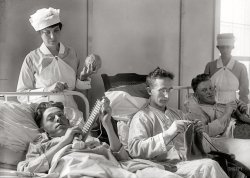
- Goggles Girl: 1942
- ... sweater doesn't look very fireproof.
Those Goggles Rosie clearly has a nice set!
Cutting or welding? Perhaps someone with ... what's with the welding rod?
Wanda We have seen "Rosie the Riveter", so she must be "Wanda the Welder".
Predominant Wool ... Posted by Dave - 10/30/2013 - 2:33pm -
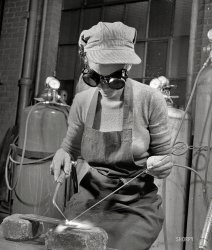
- Two Dollars a Week: 1913
- ... help the mother on garments: Joseph, 14, Andrew, 10, Rosie, 7, and all together they make about $2 a week when work is plenty. There ... Posted by Dave - 09/11/2011 - 7:18pm -
![Two Dollars a Week: 1913 New York City, January 1913. "1 p.m. Family of Onofrio Cottone, 7 Extra Place, finishing garments in a terribly run down tenement. The father works on the street. The three oldest children help the mother on garments: Joseph, 14, Andrew, 10, Rosie, 7, and all together they make about $2 a week when work is plenty. There are two babies." View full size. Photograph by Lewis Wickes Hine.
Mrs. C.What beautiful needlework on the tablecloth and curtains! And an embroidery hoop on the wall. This lady knew her way around a needle and thread.
Extra, ExtraExtra Place on the Lower East Side today in Google Maps Street View. The plywood construction fence is the east side of Extra Place.
View Larger Map
The CottonesOnofrio Cottone of 7 Extra Place became a United States citizen on Sept. 9, 1920, at New York County Supreme Court; volume 430, page 198 per Ancestry.com.
Thank you all Americans.
Joseph William Cottone of 7 Extra Place was born Dec. 2, 1898, in Italy according to his World War I registration card.
Beautiful but SadWhat a beautiful little girl that is third from left. Such a wistful and sad expression, though.
What money cannot buyThis family obviously had very little in the way of material goods, but that mom was "home schooling" before it became fashionable. These kids spent TIME with their mom, and I am certain they all knew one another as few families do today, what with endless hours of conversation and each expressing their likes, dislikes, hopes, dreams and fears. Mom is probably telling her kids all about Italy and how lucky they are to be in America, even though we today see the scene as pretty dismal. (World War I was happening at this time, and hopefully they all were spared that era of European suffering). How many kids today have heard daily stories of their parents' experiences and details of their country of origin? And I am impressed that even though they work at home, each one is DRESSED in real clothing and not pajamas or sweats. When one is a child, there is nothing so precious as your family spending time with you, talking and listening to you, acknowleging your existence, making you feel useful and needed. Yes, they were poor in being without luxuries, but they were very rich to be blessed with such close family relationships and time spent together. Lots of today's kids should be so lucky.
ThreadsMy father and his sister were not allowed outside to play. They sat inside and their job was to cut the threads on the purses their mother was sewing beads onto. He does not remember enjoying the activity, but his parents were terrified of losing another child, as their first son was killed by an automobile, part of what was referred to by the local paper at the time as an epidemic. The board of health finally forced my grandmother to let her children attend school when my father was 7 years old.
Home schoolingAnd as for the comment about the wonders of home schooling, at least in my father's and mother's families, (both of Italian heritage) once the children appeared to be old enough to do the work, that's what their parents expected them to do. Reading, writing and arithmetic, even with literate parents (all my grandparents were literate) was not taught in the home. They were hungry and poor and their precious time was spent making paper flowers, sewing, beading, whatever piece work their families worked on.
Extra PlaceNY Times article about Extra Place, off East First Street near the Bowery. Seems as though there's a dispute about whether or not the byway should be eliminated at the expense of new upscale apartment construction. The back door of the CBGB Hard Rock club exited into Extra Place.
Round thing on the wallThat round thing on the wall above the little girl's head on the right hand side of the picture seems to be a wooden flour sifter with a wire mesh bottom. I have one like it for decoration in my kitchen (brought over from Italy). Why it would be so important to hang it in the living room is beyond me unless it might be an Italian custom of some sort (good luck perhaps?).
[It's an embroidery hoop. - Dave]
Sweet NewsPosted today on Gothamist:
"A compact chocolate shop called Bespoke Chocolate opened yesterday on Extra Place, the historic 30' by 120' alley tucked away north of 1st Street between the Bowery and 2nd Avenue. The shop itself, owned and operated by chocolate maker Rachel Zoe Insler and her fiancé, is a tiny 280 square feet, open production space included."
Must disagree with Dave, uh oh!An embroidery hoop needs to be "hollow" you cannot embroider if a screen/net is attached to one side. My vote goes is for sifter also.
(The Gallery, Kids, Lewis Hine, NYC)](https://www.shorpy.com/files/images/05508u.thumbnail.jpg)
- Santa's Helpers: 1924
- ... The dance numbers starred the Dolly Sisters, Jennie and Rosie, and this contemporary photo of them suggests that they were never ... Posted by Dave - 08/19/2012 - 5:05pm -
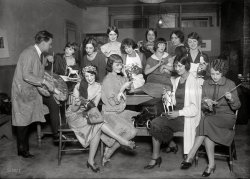
- Midnight Snackers: 1943
- ... somewhere overseas instead of sitting at a lunch counter; Rosie could replace them at their drill press.
Dave
Clark Gable from an ... Posted by Dave - 10/14/2014 - 1:34pm -
![Midnight Snackers: 1943 "We'll have what she's having."
April 1943. "Baltimore, Maryland. Third-shift defense workers getting snack at drugstore on corner where their shared car will pick them up around midnight." Photo by Marjory Collins for the Office of War Information. View full size.
Fancy ClienteleThere's Clark Gable on the left, and Elvis peeking over the root beer barrel.
Clark GableSeated in front of the Coca Cola dispenser
I'll have a slice of life, please.Looks like everyone but the woman with the fur trimmed coat collar, the guy in the leather jacket next to her, and the man standing behind them in the fedora are all wearing workingman's clothes. There must be a story in there somewhere. The fedora guy could be an upstairs management type or a news reporter trying to get a cuppa on his way home. Leather jacket and fur collar might have stopped in to the drugstore to have something to eat on their way home from a date at the movies when the shift at the plant let out and they were instantly surrounded. At least they all seem to look happy or at least amused about something.
Interesting reading on the walls. A 'How To Buy' wartime poster. On the magazine rack above there's Official Detective, Photoplay, Esquire and War News and a magazine titled Gags with a girl behind a steering wheel. If it's about gags, this may not end well for her. Anyone recognize the actress on the cover of Photoplay?
[Gene Tierney, April 1943. -tterrace]
Is it a clown car?Thats an awful lot of people to squeeze into one vehicle. I'm assuming 'car' must refer to something somewhat larger than what immediately springs to mind for me.
["Car" was also common shorthand for streetcar. -tterrace]
Here Comes The JudgeI have never heard of or even seen any old copies of "Judge" magazine. It was a humor magazine that started in 1881.
Couldn't find the issue shown here in the magazine rack, but here's a cover from later that year.
"Car" = "Streetcar"......Notice the folded-back blackout curtains by the entrance. Hmmm, those two young ones nearest the camera look like they should be toting a gun somewhere overseas instead of sitting at a lunch counter; Rosie could replace them at their drill press.
Dave
Clark Gable from an alternate universeThe one where he just wasn't quite handsome enough to make it as a movie star.
Another gem to gaze at for hours!Just when I think Shorpy can't be any more remarkable comes this photo. We are all there as the flash goes off. Thanks for the ride, Dave.
Lost (?) stampsOne of my few wartime memories is of my mother in a panic having 'lost' her food ration stamps like those pictured in the poster in the upper right. I mobilized all the kids on the block to find them. We diligently searched her path from the neighborhood grocery store (that was in pre-supermarket times) to our rented flat only to find that she had miss-filed them in her voluminous purse. Come to think of it that term, super market, has vanished from common usage along with the stamps.
I'm assuming....Are those black-out curtains in front of the doorway?
(The Gallery, Baltimore, Eateries & Bars, Marjory Collins, Stores & Markets)](https://www.shorpy.com/files/images/SHORPY-8d28338u.thumbnail.jpg)
- Riveting: 1942
- ... transparency by Howard Hollem.
Mom! My mom, Rosie (real name), worked at a food dehydrator in WWII (not as a riveter). She ... Posted by Dave - 07/17/2012 - 10:09pm -
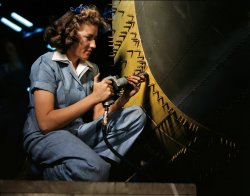
- Future Fridge: 1959
- ... duration of WW2 advertising the things that GIs and their Rosie the Riveter wives could look forward to after victory, and one of those ... Posted by Dave - 07/16/2018 - 10:54am -
![Future Fridge: 1959 1959. "Anne Anderson in RCA-Whirlpool 'Miracle Kitchen of the Future,' a display at the American National Exhibition in Moscow." Photo by Bob Lerner for the Look magazine article "What the Russians Will See." View full size.
Retractable FridgeThe RCA-Whirlpool "Finger-Chopper," Model FC-1959.
Predictions can be wrong“Miracle Kitchen” from back in the day when they predicted nuclear power would make electricity too cheap to meter. Yeah, right.
June Lockhart, Barbara Billingsley, TV moms, etc.This lady could be any one of the bunch with that outfit and string of pearls. Except Dale Evans.
Eggs?If I'm understanding this, what the Russians will see is somebody refrigerating eggs, which pretty much nobody but Americans does.
At long last, will no one mention the Kitchen Debate?This was expected to be the propaganda coup for western capitalism. US corporations spent the duration of WW2 advertising the things that GIs and their Rosie the Riveter wives could look forward to after victory, and one of those things was the modern kitchen. Whatever western intelligence services had to guess about the home lives of communist-bloc nations, they could be pretty confident of a lag in kitchen convenience technology. Ike tasked his veep, Richard Nixon, with hammering this point home, in his debates with Khruschchev.
[Actually we have mentioned it, here and here. - Dave]
USA! USA! USA!Looks like we were winning the "cold war" in 1959.
GE preceded RCA-Whirlpool by two yearsIn 1957, some friends had an identical wall-mounted model in a brown tone, but it was relegated to their garage/shop in 1964 during a remodeling. When they sold the house in 1983 it was still working perfectly.
[Hardly identical. This was a motorized unit that retracted up into the cabinets with a wave of the hand. - Dave]
Caesar SaladDiscovered by keeping the eggs over the lettuce.
Why yesI remember this disinformation campaign well. Our 1959 kitchen looked just like it. Not. The oil stove and refrigerator which iced up regularly featured as did the mangle-equipped clothes washer. Forget the Russians, most people I knew wanted a kitchen like that depicted.
At least we got an over-and-under auto defrost freezer/fridge in contemporary lime green plus a new electric range and washer and dryer when Dad remodeled in 1962! And a double sink. Don't forget that double sink! Luxury. We also got a Roto-Tiller for the veggie garden and a snow blower for the driveway. The future had arrived.
Then I went to London for grad school in 1969. The kitchens I saw there resembled the ones from the '30s shown here on Shorpy but with full-size gas ranges.
(Technology, The Gallery, Kodachromes, Kitchens etc., LOOK)](https://www.shorpy.com/files/images/SHORPY-12326u2.thumbnail.jpg)
- Teamwork: 1942
- ... blatantly and utterly posed.
Look at how the supposed "Rosie" is dressed, right down to gleaming shoes. Do you think for a moment ... Posted by Dave - 03/19/2016 - 10:05am -
![Teamwork: 1942 October 1942. "Men and women make efficient operating teams on riveting and other jobs at the Douglas Aircraft plant, Long Beach, Calif. Most important of the many types of aircraft made at this plant are the B-17F 'Flying Fortress' heavy bomber, the A-20 'Havoc' assault bomber and the C-47 heavy transport plane shown here for the carrying of troops and cargo." 4x5 inch Kodachrome transparency by Alfred Palmer for the Office of War Information. View full size.
What? What?What did you say? what?
Great picture!The composition, the color - just a beautifully composed shot.
Riveting!I just had to say it: This is a riveting photo! ;-)
I love the chiaroscuro, the focussed concentration, the saturated colors, the flesh tones and the gray metal.
They are both beautiful people, too!
MOM!No comment necessary
Blatantly, Utterly PosedTechnically, it's a great feat of photography, but, like many Office of War Information photos, this image is blatantly and utterly posed.
Look at how the supposed "Rosie" is dressed, right down to gleaming shoes. Do you think for a moment that even the most unsophisticated viewer would not instantly recognize this as propaganda ?
Would it not be more informative to have captured the way the work was actually being conducted ? Would that not instill greater appreciation of the war effort in the general public?
On the plus side, the models are at least holding the rivet gun and the bucking bar in the correct alignment.
[These photos were used to produce posters and other promotional materials intended to motivate women to work in war-related industries; in other words, advertising, not documentation. -tterrace]
C-47Dad flew as aerial engineer / crew chief on C-47's in the Pacific War. Battle Stars for Guadalcanal and Northern Solomons. His unit, the "Thirsty 13th" Troop Carrier Squadron island hopped for almost 4 years. Places and air strips long since forgotten.. Dumbea, New Hebrides, New Caledonia, Espiritu Santos, etc. . C-47's were unarmed, flew low and slow, frequently to airstrips carved out of the jungle at the front lines (ie Guadalcanal). His unit lost aircrews. Also, heavy experience with malaria (take your Atabrine !!) and combat fatigue. C-47's were also used to tow gliders to the front lines. Dad made the Sep 7 1942 cover of Life in a "war glider". Dad never discussed much of his experience, but made sure we remembered his lost friends. Mom served in the Atlantic. Greatest generation indeed.
This photo series... famous, yes posed, but served an important function. Front line airmen depended on the manufacturing excellence portrayed in the series.
Posed? Of course!Made a pretty decent living taking photos like that. They were posed because the people who were paying me to take them wanted them that way. The shot we're discussing here is a beaut. Alfred Palmer made what could have been a snoozer most compelling.
When I was taking photos for newspapers, I still would, depending on the situation, ask the subjects to move this way or that way, so you could say those were posed, too. Most of the stuff I shot captured students of the month or new garden club officers. I wanted the subjects, who would be happy to be in the next edition of the paper, to look nice and for the photo to reproduce well as 65dpi black-and-white printed on newsprint.
Sports stuff, crime (what little I ever took) stuff: not posed but not always good, either!
Posed or not...Yes, it's obvious that the photo was posed. As tterrace noted, this and other similar photos seen here on Shorpy were used to create posters and other paraphernalia for the War effort.
But... My Grandmother worked in an aircraft plant during the War. She worked on an assembly team, not riveting but an equally taxing and dirty job. She had several photos I've seen that showed her daily outfits and for the most part it looks like she always tried to look her best, at least in the morning. She actually wore her hair the exact same way.
Yeah, there were (and still are) a lot of dirty jobs but you only have to peruse the photos in Shorpy for a bit to tell that people took the time to dress better, more formal back then.
(The Gallery, Kodachromes, Aviation, Factories, WW2)](https://www.shorpy.com/files/images/SHORPY-1a35338u.thumbnail.jpg)
- Window Shopping: 1943
- ... Madame would be interested in something from the "Rosie the Riveter" collection?
Ironic Ironic that Spiegel, Sears, and ... Posted by Dave - 05/25/2016 - 12:40pm -
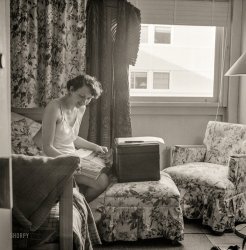
- Chinese Temple: 1940
- ... all those years ago when he ordered a Grape Nehi at Rosie's Bar. Not being a citizen of the US.
Jimmy D. The driver of the ... Posted by Dave - 03/10/2019 - 5:12pm -
